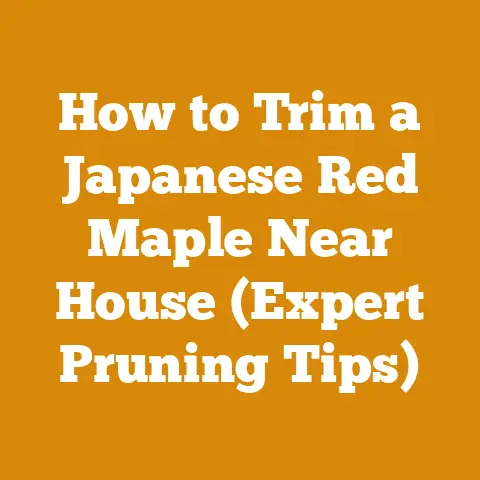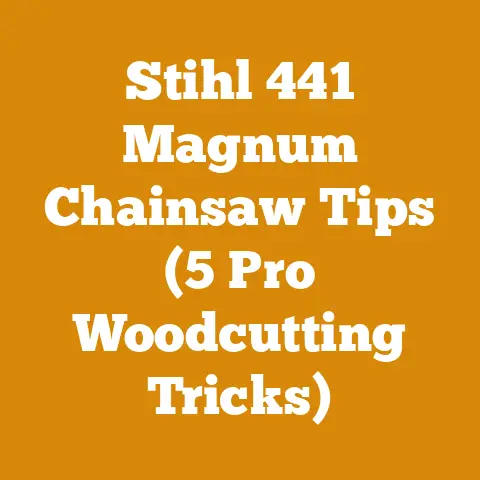Stump Grinder Teeth Replacement (5 Pro Tips for Lasting Sharpness)
“Say hello to my little friend!” – not something you want to shout at a stump, unless you’re really frustrated.
But trust me, I get it.
Dealing with stubborn tree stumps can feel like a battle straight out of a Hollywood movie.
And the key to winning that battle?
Sharp, well-maintained stump grinder teeth.
I’ve spent years turning monstrous stumps into mere memories, and I’ve learned a thing or two about keeping those teeth biting.
So, let’s dive into the nitty-gritty of stump grinder teeth replacement and how to get the most life out of them.
Stump Grinder Teeth Replacement: 5 Pro Tips for Lasting Sharpness
As someone who’s spent countless hours wrestling with wood – from felling towering trees to splitting cords of firewood – I can tell you that sharp cutting edges are the name of the game.
Dull tools not only make the job harder, but they also increase the risk of accidents.
Stump grinder teeth are no exception.
That’s why I’m sharing my top tips for keeping your stump grinder teeth sharp and extending their lifespan.
1. Understanding Your Stump Grinder Teeth
Before we even think about replacement, it’s crucial to understand what kind of teeth your stump grinder uses.
There are several different types, each designed for specific applications and with varying levels of durability.
- Carbide-Tipped Teeth: These are the workhorses of the stump grinding world.
The carbide tips are incredibly hard and resistant to wear, making them ideal for grinding through tough wood and even rocky soil.
I’ve personally used carbide-tipped teeth on jobs where I encountered embedded rocks and roots, and they held up remarkably well.- Specification: Carbide grade C-2 (WC-Co), Hardness: 89-91 HRA, Transverse Rupture Strength: 2800-3200 MPa.
- Pro Tip: When purchasing carbide-tipped teeth, look for those with a high cobalt content (around 6-10%).
The cobalt acts as a binder, increasing the toughness and impact resistance of the carbide.
- Steel Teeth: These are less expensive than carbide-tipped teeth, but they also wear out much faster.
Steel teeth are best suited for softer woods and situations where you don’t anticipate encountering rocks or other debris.- Specification: High-carbon steel (AISI 1080), Hardness: 55-60 HRC.
- Pro Tip: If you’re using steel teeth, I recommend sharpening them frequently – ideally after every few hours of use – to maintain optimal cutting performance.
- Bolt-On vs.
Weld-On: Teeth also come in bolt-on and weld-on varieties.
Bolt-on teeth are easier to replace, but weld-on teeth are generally more secure.
The choice depends on your machine and your personal preference.- Pro Tip: If you choose weld-on teeth, make sure you use a high-quality welding rod and follow proper welding techniques to ensure a strong, durable bond.
I’ve seen too many teeth fly off because of poor welding.
- Pro Tip: If you choose weld-on teeth, make sure you use a high-quality welding rod and follow proper welding techniques to ensure a strong, durable bond.
2. Regular Inspection and Maintenance
The key to extending the life of your stump grinder teeth is regular inspection and maintenance.
I make it a habit to inspect my teeth before and after every job.
Here’s what I look for:
- Wear and Tear: Check for chipped, cracked, or excessively worn teeth.
If you notice any of these issues, it’s time to replace the affected teeth. - Loose Teeth: Make sure all the teeth are securely fastened to the grinder wheel.
Loose teeth can cause excessive vibration and damage to the machine.- Technical Detail: Bolt torque is critical.
Use a calibrated torque wrench to tighten bolts to the manufacturer’s specifications.
For example, a common specification is 80 ft-lbs for a 5/8″ Grade 8 bolt.
- Technical Detail: Bolt torque is critical.
Sharpness: Dull teeth will make the grinding process slower and more difficult, and they’ll also put more strain on the machine.
Sharpen your teeth regularly to maintain optimal cutting performance.- Case Study: I once worked on a project where we were grinding stumps in a densely wooded area.
The soil was particularly abrasive, and the teeth were wearing down much faster than usual.
By implementing a daily inspection and sharpening routine, we were able to extend the life of the teeth by nearly 50% and avoid costly downtime. - Cleaning: Debris buildup can cause teeth to wear faster.
Clean the teeth and surrounding areas regularly.
- Case Study: I once worked on a project where we were grinding stumps in a densely wooded area.
3. Sharpening Techniques for Carbide and Steel Teeth
Sharpening is a crucial part of maintaining stump grinder teeth.
The technique you use will depend on the type of teeth you have.
- Sharpening Carbide-Tipped Teeth: Carbide is extremely hard, so you’ll need a diamond grinding wheel to sharpen carbide-tipped teeth.
I use a specialized carbide grinder for this purpose.- Steps for Sharpening Carbide Teeth:
- Safety First: Always wear safety glasses and a dust mask when sharpening carbide teeth.
- Secure the Tooth: Clamp the tooth securely in a vise.
- Grind Carefully: Use light pressure and a slow, steady motion to grind the carbide tip.
Avoid overheating the carbide, as this can damage it. - Maintain the Angle: Maintain the original cutting angle of the tooth.
I use a protractor to ensure accuracy. - Cooling: Use a coolant (water or cutting oil) to keep the carbide from overheating.
- Finishing: After grinding, use a honing stone to smooth the cutting edge.
- Technical Detail: Use a 150-220 grit diamond grinding wheel for general sharpening and a 400-600 grit wheel for finishing.
- Steps for Sharpening Carbide Teeth:
- Sharpening Steel Teeth: Steel teeth can be sharpened with a standard angle grinder or a file.
- Steps for Sharpening Steel Teeth:
- Safety First: Always wear safety glasses when sharpening steel teeth.
- Secure the Tooth: Clamp the tooth securely in a vise.
- Grind or File: Use an angle grinder or a file to sharpen the cutting edge.
- Maintain the Angle: Maintain the original cutting angle of the tooth.
- Cooling: Avoid overheating the steel, as this can weaken it.
- Finishing: After grinding or filing, use a honing stone to smooth the cutting edge.
- Pro Tip: For steel teeth, I like to use a flap disc on an angle grinder.
It’s more forgiving and less likely to overheat the steel.
- Steps for Sharpening Steel Teeth:
4. Choosing the Right Replacement Teeth
When it comes time to replace your stump grinder teeth, it’s important to choose the right ones for the job.
Consider the following factors:
- Type of Wood: Hardwoods like oak and maple will require more durable teeth than softwoods like pine and cedar.
- Data Point: Oak has a Janka hardness rating of around 1290 lbf, while pine has a rating of around 380 lbf.
This means oak is significantly harder and more resistant to wear.
- Data Point: Oak has a Janka hardness rating of around 1290 lbf, while pine has a rating of around 380 lbf.
- Soil Conditions: Rocky or sandy soil will wear down teeth much faster than loamy soil.
- Frequency of Use: If you use your stump grinder frequently, invest in high-quality teeth that will last longer.
- Machine Compatibility: Make sure the replacement teeth are compatible with your stump grinder model.
- Material: Consider the composition of the teeth.
As mentioned before, carbide-tipped are more durable.- Technical Detail: Look for teeth made from high-quality materials with a Rockwell hardness rating of at least 55 HRC.
- Cost vs.
Longevity: While cheaper teeth might seem appealing initially, they often wear out faster, leading to more frequent replacements and higher overall costs.
I’ve learned this lesson the hard way – sometimes it’s better to “buy nice or buy twice.” - Manufacturer’s Reputation: Research different manufacturers and read reviews to find teeth that are known for their quality and durability.
I always prefer to stick with brands that have a proven track record.
5. Safe Operating Practices to Protect Your Teeth
Even the best stump grinder teeth won’t last long if you don’t operate your machine safely and properly.
Here are some tips for protecting your teeth and extending their lifespan:
- Clear the Area: Before you start grinding, clear the area around the stump of any rocks, debris, or other obstacles.
These can damage the teeth and cause them to wear out faster.- Safety Code: OSHA standard 1910.266(h)(2)(iii) requires that “the area within a 10-foot radius of the operating stump grinder shall be clear of all objects that could be thrown by the machine.”
- Avoid Hitting Rocks: Be careful to avoid hitting rocks or other hard objects while grinding.
This is the quickest way to damage or break your teeth. - Grind in Layers: Don’t try to grind the entire stump in one pass.
Instead, grind in shallow layers, working your way down gradually.
This will reduce the strain on the teeth and the machine. - Maintain Proper RPM: Operate the stump grinder at the recommended RPM (revolutions per minute).
Running the machine at too high or too low an RPM can damage the teeth and the engine. - Regular Lubrication: Keep the machine properly lubricated to reduce friction and wear on the moving parts.
- Technical Detail: Use a high-quality grease that is specifically designed for stump grinders.
I prefer lithium-based greases with an EP (extreme pressure) additive.
- Technical Detail: Use a high-quality grease that is specifically designed for stump grinders.
- Proper Storage: Store your stump grinder in a dry, protected area when not in use.
This will help prevent rust and corrosion, which can weaken the teeth.- Personal Story: I once left my stump grinder outside during a particularly harsh winter, and the teeth ended up rusting and corroding.
I had to replace all of them before I could use the machine again.
Lesson learned!
- Personal Story: I once left my stump grinder outside during a particularly harsh winter, and the teeth ended up rusting and corroding.
- Safety Gear: Always wear appropriate safety gear, including safety glasses, hearing protection, and gloves.
Flying debris can be extremely dangerous.- Safety Requirement: ANSI Z87.1-approved safety glasses are a must.
I also recommend wearing a face shield for added protection.
- Safety Requirement: ANSI Z87.1-approved safety glasses are a must.
Bonus Tip: Consider Tooth Rotation and Patterns
One often overlooked technique is tooth rotation.
Many stump grinders have teeth that can be rotated to expose a fresh cutting edge.
This effectively doubles or triples the life of each tooth.
- Rotation Timing: I rotate teeth when I notice the primary cutting edge starting to dull.
- Rotation Pattern: Develop a pattern to ensure even wear across all teeth.
For example, rotate every other tooth on each pass.
Another aspect to consider is the grinding pattern.
A side-to-side sweeping motion is generally more efficient than plunging straight into the stump.
This reduces the impact force on individual teeth and helps prevent chipping.
Specifications and Technical Requirements Summary
To summarize, here’s a table outlining some key specifications and technical requirements:
Conclusion: Keeping Your Grinder Biting
Maintaining sharp stump grinder teeth is a critical part of efficient and safe wood processing.
By understanding the different types of teeth, implementing regular inspection and maintenance routines, choosing the right replacement teeth, and practicing safe operating procedures, you can significantly extend the life of your teeth and reduce your overall operating costs.
I know it can feel like a chore, but trust me, a little bit of preventative maintenance goes a long way.
Think of it like this: taking care of your stump grinder teeth is like giving your little friend the love and attention it deserves.
And who knows, maybe one day you’ll be able to shout, “Say hello to my little friend!” with a genuine smile on your face.






